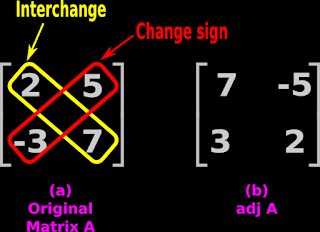In the previous section, we saw the matrix method for solving systems of linear equations. We saw a solved example also. In this section, we will see a few more solved examples.
Solved example 20.24
Solve the system of equations:
2x + 5y = 1
3x + 2y = 7
Solution:
1. The given system can be written in the form AX = B.
$A = \left[\begin{array}{r}
2 &{ 5 } \\
3 &{ 2 } \\
\end{array}\right],~X = \left[\begin{array}{r}
x \\
y \\
\end{array}\right]~~ \text{and}~~B = \left[\begin{array}{r}
1 \\
7 \\
\end{array}\right]
$
2. So X = A−1 B.
•
Check whether A−1 exists:
♦ |A| = (4 − 15) = −11
♦ |A| ≠ 0
♦ So A is a non-singular matrix. Therefore, A−1 exists.
3. Use the method in Solved example 20.21 to find A−1.
We get: $A^{-1} = \left[\begin{array}{r}
-2/11 &{ 5/11 } \\
3/11 &{ -2/11 } \\
\end{array}\right]$
4. Use matrix multiplication to find A−1B.
•
We get: X = A−1 B =
$\left[\begin{array}{r}
-2/11 &{ 5/11 } \\
3/11 &{ -2/11 } \\
\end{array}\right]~\left[\begin{array}{r}
1 \\
7 \\
\end{array}\right]~ = \left[\begin{array}{r} 3 \\
-1 \\
\end{array}\right]
$
5. So the solution is: x = 3 and y = -1
Solved example 20.25
Solve the system of equations:
3x − 2y + 3z = 8
2x + y − z = 1
4x − 3y + 2z = 4
Solution:
1. The given system can be written in the form AX = B.
$A = \left[\begin{array}{r}
3 &{ -2 } &{ 3 } \\
2 &{ 1 } &{ -1 } \\
4 &{ -3 } &{ 2 } \\
\end{array}\right],~X = \left[\begin{array}{r}
x \\
y \\
z \\
\end{array}\right]~~ \text{and}~~B = \left[\begin{array}{r}
8 \\
1 \\
4 \\
\end{array}\right]
$
2. So X = A−1 B.
•
Check whether A−1 exists:
♦ |A| = −17 (by expansion along any row or column)
♦ |A| ≠ 0
♦ So A is a non-singular matrix. Therefore, A−1 exists.
3. Use the method in Solved example 20.20 to find A−1.
We get: $A^{-1} = - \frac{1}{17} \left[\begin{array}{r}
-1 &{ -5 } &{ -1 } \\
-8 &{ -6 } &{ 9 } \\
-10 &{ 1 } &{ 7 } \\
\end{array}\right]$
4. Use matrix multiplication to find A−1B.
•
We get: X = A−1 B =
$- \frac{1}{17} \left[\begin{array}{r}
-1 &{ -5 } &{ -1 } \\
-8 &{ -6 } &{ 9 } \\
-10 &{ 1 } &{ 7 } \\
\end{array}\right]~\left[\begin{array}{r}
8 \\
1 \\
4 \\
\end{array}\right]~ = \left[\begin{array}{r} 1 \\
2 \\
3 \\
\end{array}\right]
$
5. So the solution is: x = 1, y = 2 and z = 3
Solved example 20.26
Sum of three numbers is 6. If we multiply third number by 3 and add second number to it, we get 11. By adding first and third numbers, we get double of second number. Represent it algebraically and find the numbers by matrix method.
Solution:
1. Let the numbers be x, y and z.
2. Given: Sum is 6.
•
So we can write: x + y + z = 6
3. Given: If we multiply third number by 3 and add second number to it, we get 11.
•
So we can write: 3z + y = 11.
•
This is same as 0x + y + 3z = 11
4. Given: By adding first and third numbers, we get double of second number.
•
So we can write: x + z = 2y
•
This is same as: x − 2y + z = 0
5. From (2), (3) and (4), we get three equations:
x + y + z = 6
0x + y + 3z = 11
x − 2y + z = 0
6. The given system can be written in the form AX = B.
$A = \left[\begin{array}{r}
1 &{ 1 } &{ 1 } \\
0 &{ 1 } &{ 3 } \\
1 &{ -2 } &{ 1 } \\
\end{array}\right],~X = \left[\begin{array}{r}
x \\
y \\
z \\
\end{array}\right]~~ \text{and}~~B = \left[\begin{array}{r}
6 \\
11 \\
0 \\
\end{array}\right]
$
7. So X = A−1 B.
•
Check whether A−1 exists:
♦ |A| = 9 (by expansion along any row or column)
♦ |A| ≠ 0
♦ So A is a non-singular matrix. Therefore, A−1 exists.
8. Use the method in Solved example 20.20 to find A−1.
We get: $A^{-1} = \frac{1}{9} \left[\begin{array}{r}
7 &{ -3 } &{ 2 } \\
3 &{ 0 } &{ -3 } \\
-1 &{ 3 } &{ 1 } \\
\end{array}\right]$
9. Use matrix multiplication to find A−1B.
•
We get: X = A−1 B =
$ \frac{1}{9} \left[\begin{array}{r}
7 &{ -3 } &{ 2 } \\
3 &{ 0 } &{ -3 } \\
-1 &{ 3 } &{ 1 } \\
\end{array}\right]~\left[\begin{array}{r}
6 \\
11 \\
0 \\
\end{array}\right]~ = \left[\begin{array}{r} 1 \\
2 \\
3 \\
\end{array}\right]
$
10. So the solution is: x = 1, y = 2 and z = 3
The link below gives a few more solved examples:
In the next section, we will see some miscellaneous examples.
Copyright©2024 Higher secondary mathematics.blogspot.com
























